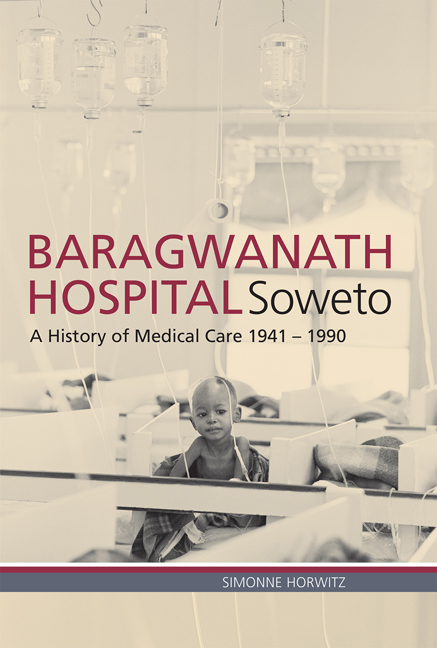Book contents
- Frontmatter
- Contents
- Acknowledgements
- List of Illustrations
- List of Abbreviations
- A note on terminology
- 1 Introduction: A Hospital in Soweto
- 2 From Allied Military Hospital to Urban African Hospital
- 3 Apartheid and Administration: The Hospital, Provincial Administration and the University of the Witwatersrand
- 4 Missionaries, Clinicians, Activists and Bara Boeties: The Doctors of Baragwanath Hospital
- 5 Black Nurses in White: The Nurses of Baragwanath Hospital
- 6 Chronic contradictions: The struggle of Baragwanath in the 1980s
- 7 Baragwanath's Transition and Legacy
- Bibliography
- Index
- Plate Section
7 - Baragwanath's Transition and Legacy
Published online by Cambridge University Press: 20 April 2018
- Frontmatter
- Contents
- Acknowledgements
- List of Illustrations
- List of Abbreviations
- A note on terminology
- 1 Introduction: A Hospital in Soweto
- 2 From Allied Military Hospital to Urban African Hospital
- 3 Apartheid and Administration: The Hospital, Provincial Administration and the University of the Witwatersrand
- 4 Missionaries, Clinicians, Activists and Bara Boeties: The Doctors of Baragwanath Hospital
- 5 Black Nurses in White: The Nurses of Baragwanath Hospital
- 6 Chronic contradictions: The struggle of Baragwanath in the 1980s
- 7 Baragwanath's Transition and Legacy
- Bibliography
- Index
- Plate Section
Summary
In 1990 South Africa entered a period of transition to democracy. President FW de Klerk announced the unbanning of the ANC, the Pan Africanist Congress and the Communist Party. Nelson Mandela and his fellow political prisoners began to be released and South Africa was on the path to its first democratic election. A new phoenix was born at Baragwanath, a phoenix that was to live through tumultuous times.
The changes in hospital policy, discussed in Chapter 1, began the process of transition. Not only was Baragwanath officially desegregated but its administration also became further centralised. This did little to affect daily functioning. The historical problems of staff shortages, lack of funding and ever-increasing patient numbers continued to plague the hospital which faced, in addition, the new challenges of HIV/AIDS, a gradual breakdown in discipline and management structures, and increasing labour tensions. The major strikes that occurred at the hospital in 1992 and 1995 set the background for Baragwanath's transition, one marked by continuity and change.
According to the South African Medical Journal of August 1992, the first diagnosed cases of HIV/AIDS were recorded at Baragwanath in 1987. By December 1990, 181 HIV-positive black adults had been admitted to the medical wards. Four times this number had been identified as HIV-positive. Half of these patients were in the late stages of HIV infection and two years later thirty-four per cent of those diagnosed in 1990 had died. In 1990, fiftyone symptomatic children were also identified at Baragwanath.
Over the next few years the numbers continued to grow and HIV/ AIDS quickly became an important aspect of the increasing workload and the increase in in-hospital mortality. HIV-related paediatric deaths during hospital stays at Baragwanath increased from eleven children in 1992 to 111 deaths in 1996. Seeing the challenges that HIV/AIDS was posing for the hospital, even in those early years, the Department of Obstetrics and Gynaecology and that of Paediatrics at the University of the Witwatersrand developed the Baragwanath Perinatal HIV Research Unit which was initiated in 1991 by Dr James McIntyre. By 1995 the unit was formalised, and it has continued to be overseen by McIntyre and Dr Glenda Gray.
- Type
- Chapter
- Information
- Baragwanath Hospital, SowetoA history of medical care 1941–1990, pp. 200 - 211Publisher: Wits University PressPrint publication year: 2013

